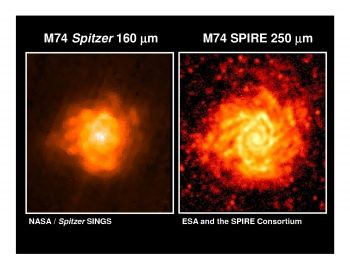Broadcast: News items
Space camera throws light on wonders of the Universe
By: Alison Field
Last updated: Friday, 10 July 2009

One of the first images of galaxies from the SPIRE camera on board the Herschel space telescope
Sussex scientists are delighted with the first - and spectacular - images from the Herschel Space Observatory, published today (Friday 10 July).
On 24 June, SPIRE was able to observe the sky for the first time following its launch on 14 May 2009. The telescope was trained on two galaxies to get a first impression of what the instrument could see. The results were better than anyone expected from first observations. Many other, more distant, galaxies were also seen in the field of view.
The images show in detail the formation of stars within the observed galaxies in stunning detail, offering a sneak preview of future observations that promise to revolutionise scientific understanding of star formation. Because these galaxies are so far away, their light has taken a very long time to reach us, so by detecting them we are looking into the past and learning how and when galaxies like the Milky Way were formed.
The images, released by the European Space Agency (ESA), were made possible by the observatory's SPIRE (Spectral and Photometric Imaging Receiver) camera.
A team including members of the Sussex Astronomy Centre contributed to the design and development of the SPIRE Instrument Control Centre.
Dr Seb Oliver, a Reader in Astronomy in the Physics and Astronomy department, has been involved with the SPIRE instrument on Herschel since it was first proposed.
Speaking after seeing the first images, he said: "They are fantastic. It is as though we have woken up as superheroes with the special power to see the secret side of galaxy formation previously hidden by invisibility cloaks."
Sussex will also play a key role in Herschel's biggest project, HerMES, which will be coordinated by Seb and which will produce a map of the Universe as it was around eight billion years ago, based on the SPIRE data. Seb says: "We expect to discover around 100,000 galaxies captured when they were in the process of forming their stars."
Sussex team member Dr Isaac Roseboom said: "For the first images back from the SPIRE instrument these are simply amazing. For the instrument to perform this well straight away is a very pleasant surprise, and a testament to the hard work and careful preparation put in by the SPIRE team. Given the clarity and amazing detail it is clear that we will be able to hit the ground running when it comes to the scientific analysis of Herschel SPIRE data.
Isaac and the Sussex team will now be processing the raw SPIRE data from the telescope into images and catalogues of sources. Isaac says: "My role will be to look at the properties of those galaxies captured by Herschel at other wavelengths - for example those featured in the images produced by the Hubble space telescope, or even ground-based telescopes."
Herschel's major objective is to discover how the first galaxies were formed and how they evolved to give rise to present-day galaxies like our own. Using infrared technology, which detects radiation from very cold and distant objects, such as young stars and evolving galaxies, the Herschel observatory will allow scientists to study other planetary systems and the birth of galaxies in the distant, early Universe.
Sussex has a specific responsibility for developing and testing software to detect stars and galaxies and measure their properties, which is being carried out by postdoctoral fellow Dr Anthony Smith.
The HerMES team at Sussex also includes postdoctoral fellows Dr Duncan Farrah and Dr Lingyu Wang.

